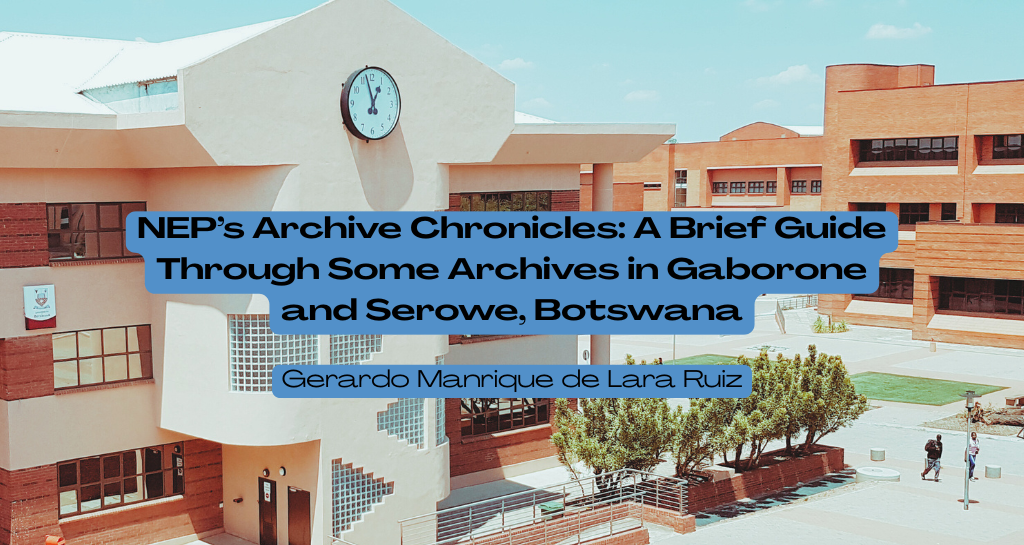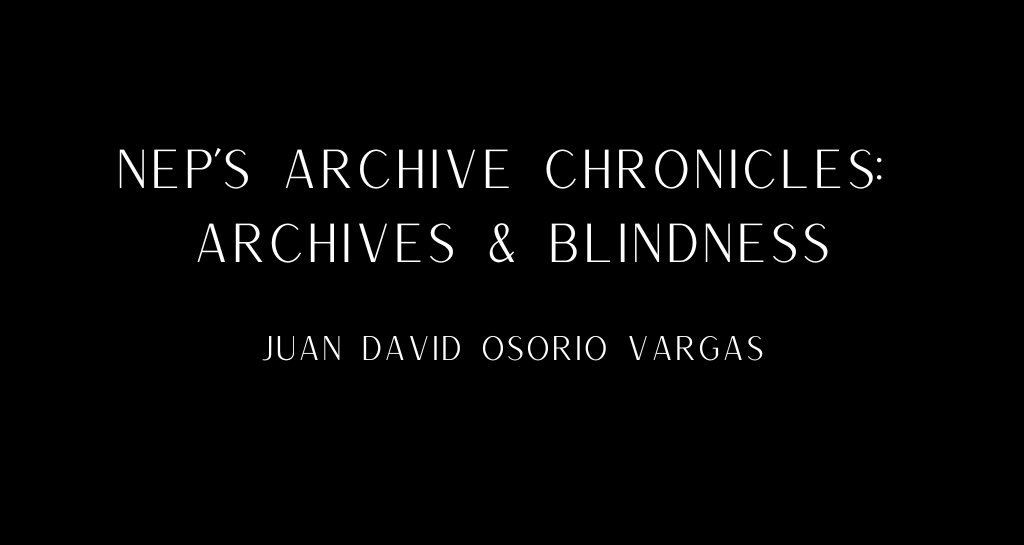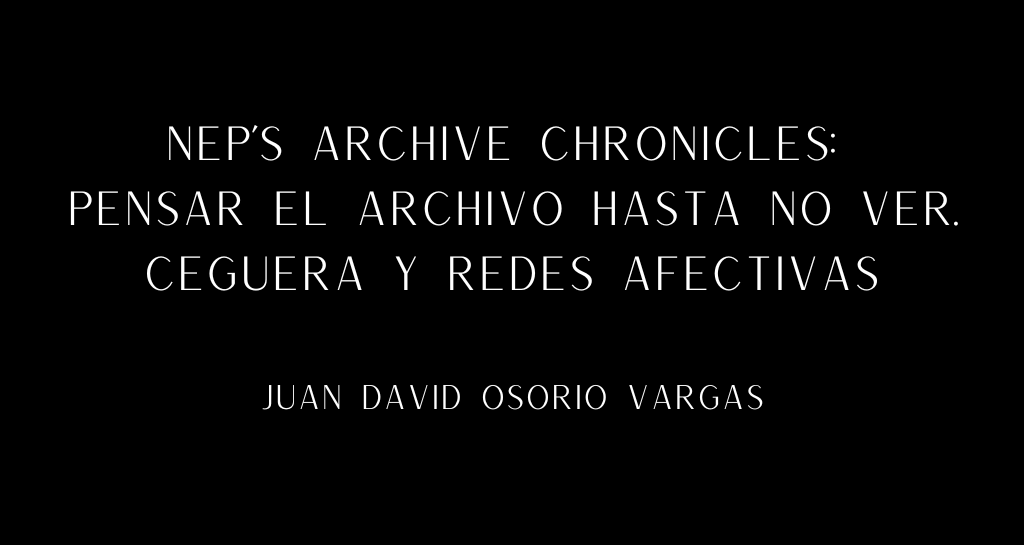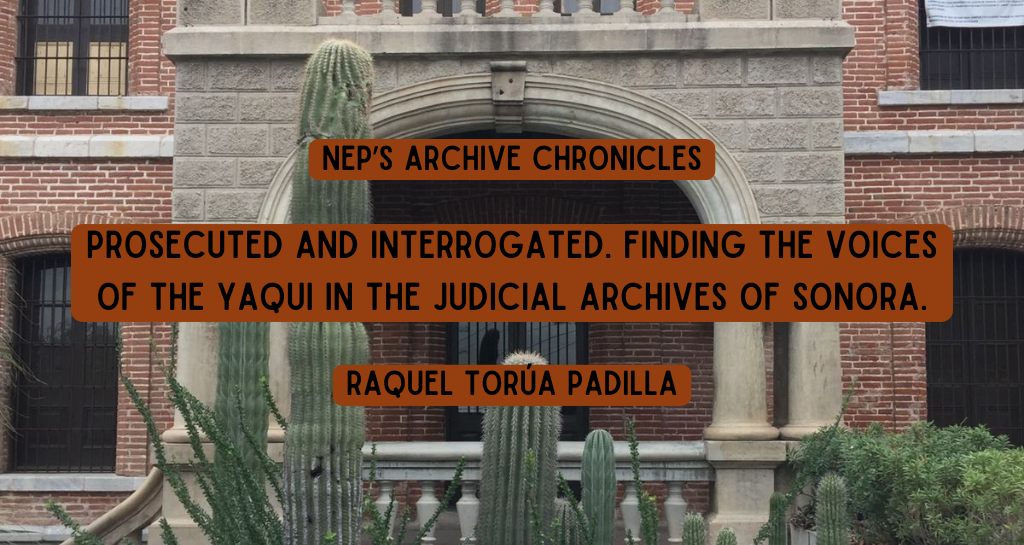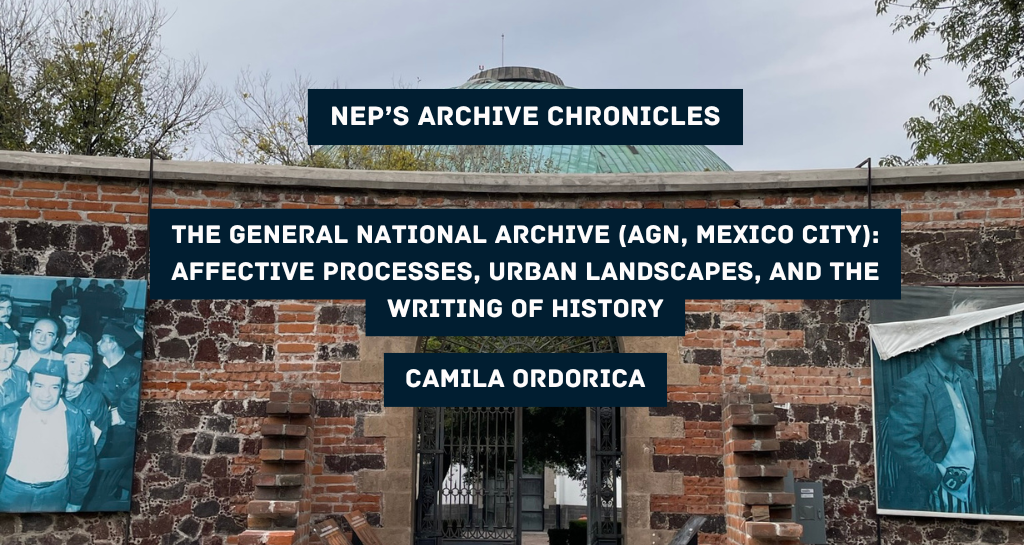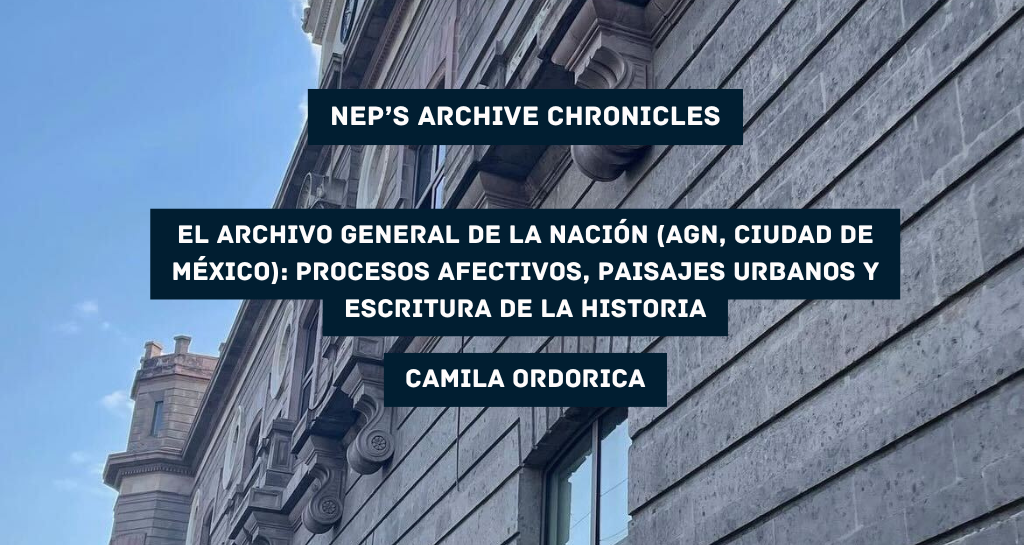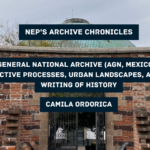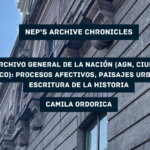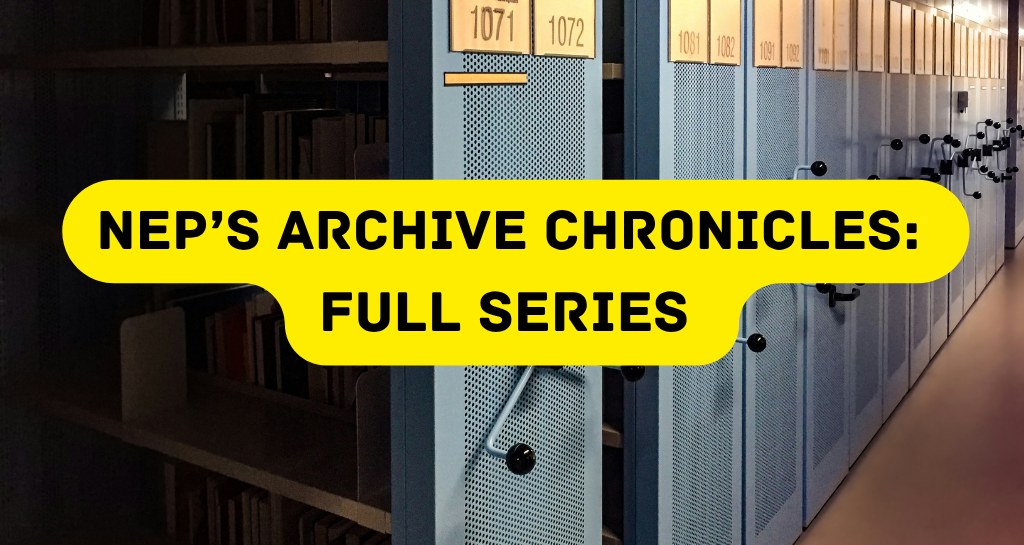
In this page, we bring together the full collection of NEP’s Archive Chronicles!
Curated by Associate Editor Camila Ordorica, this series explores archives as affective and historical spaces in their own right, while offering insights into the process of conducting archival work. Each installment provides a unique perspective on the treasures and challenges researchers encounter in the archives of the world. NEP’s Archive Chronicles is both a practical guide and a reflective space, showcasing contributors’ experiences with archival research. Browse the full series and dive into this global journeys through the archives.
Click the images below to access the pieces.
Gerardo Manrique de Lara Ruiz – Archives in Botswana
In, “A Brief Guide Through Some Archives in Gaborone and Serowe, Botswana”, Gerardo Manrique de Lara Ruiz presents an overview of the main archives in Botswana where he has conducted research for his doctoral project.
“I have visited several archives in Botswana in past years as part of my pre-dissertation research on the practices and strategies of people under colonial rule. My research focuses on how people, from local rulers to marginalized communities, used new institutional frameworks like colonial courts and councils to advance political and economic claims. At first, I was looking for records that would speak to the relationships between politically active Batswana leaders and the colonial administration. As a foreigner, Botswana’s archives were initially a black box. Discovering access routes and figuring out the kinds of documents I needed became parge piece of the intellectual puzzle I was trying to solve. Slowly and with the help of many kind archivists, librarians, interns, and museum directors I have become more familiar with Botswana’s archival repositories”
Michaela Feinberg: Archives in Senegal
In “Unexpected Archives: Unexpected Archives. Exploring student notebooks at the Institut Fondamental d’Afrique Noire (IFAN) in Senegal” Michaela Feinberg writes about the Cahiers William Ponty, a collection of school book assignments produced by students in the early 20th century, through which she studies dance and performance art in Senegal.
“I visited IFAN to access one very specific collection in its library – the cahiers (or notebooks) that students produced each summer. When I began studying theater and dance, the last thing I expected to be doing was reading the summer assignments of the Ponty students. At the same time students began to write plays, they undertook a separate but (I suggest) interconnected assignment in the summer of their third year. As part of their final grade, they were asked to return home to their villages and produce cahiers (notebooks) on topics like cuisine, dreams, and music. These cahiers can be as long as 75 pages, all handwritten and beautifully illustrated. Students were clearly trained in ethnography and art and meticulously rendered images and descriptions of daily life. They were asked to be translators (often literally) of their cultures and experiences and make these things palatable and legible to their French instructors”.
Juan David Osorio Vargas: Archives and Blindness
In this piece, published in English and Spanish, Juan David Osorio Vargas explores the connection between archives and blindness.
“As a blind historian, I am convinced that forms of knowledge organized through other senses are valuable in themselves. The question of whether a blind historian can access materials from the visual world is met with a clear yes. We can develop a language with these characteristics if we significantly expand the democratizing reach of the archive, as well as the questions surrounding it, through compensatory technologies that ensure the translation from one record to another does not lose its legitimacy.”
“Para quienes no vemos, sabemos que el archivo aparece desde el momento en que se accede a cualquier institución que custodia materiales y lleva su nombre. El archivo es todo este circuito material que lo sostiene. Su inaccesibilidad es un testimonio tangible de un tiempo pasado, con sus escaleras diseñadas para ciertos cuerpos, con ubicaciones en lugares que filtran ruido, y su ambiente predominantemente visual, desde el catálogo hasta el material de consulta, en su mayoría ilegibles para quienes no están inmersos en la lógica visual.”
Diana Heredia: The Archive of Indies
In “An experiential approach to the Archive of Indies” and “Tips for using PARES (Portal de Archivos Estatales)” Diana Heredia-López explores the Archive of Indies in Spain and shares research tips on how to navigate its digital platform, PARES.
“Among historians, the Spanish State archives are notorious for their cumbersome and restricted approach to digitization. Until only recently, researchers were strictly forbidden from taking photos at the AGI and therefore had to request the archivists to digitize sections of the archive, a process that could take many months if not years. Yet, it would be surprising for many to hear that the AGI and other Spanish state archives were pioneers in digitization, launching PARES online fourteen years ago. From then on, researchers and accidental historians like me have been able to use this archive at a scale, speed, and distance unimaginable three decades ago. For better or for worse, virtually every scholar of Colonial Latin America now begins their archival journey with digitized documents from PARES, which account at best for about 10% of their holdings. The AGI has now fully digitized diverse subsections such as Listas de Pasajeros (located in Contratación), Patronato, most of the bound books in the Gobierno Section (see Part 2), and a good portion of illustrations, maps, and material culture contained in Mapas, Planos y Estampas (MP-Estampas).”
This article includes a step-by-step guide on how to use PARES, divided in two parts:
1) How to explore the AGI’s numerous subsections or how to use PARES like a print catalog.
2) How to find digitized files that do not look like they have been digitized.
Raquel Torúa Padilla: The judicial archives of Sonora, Mexico
This installment written by Raquel Torua explores the complexities of finding the voices of the Yaqui people in the archives of Sonora. This piece is available in English and Spanish
“To address the challenge of finding the voices of the Yaqui in the primary documents, recently I have turned to judicial archives as a valuable alternative source for accessing Indigenous testimonies. Hermosillo, the capital city of Sonora in northwest Mexico, is home to two public archives that house juridical documents: the General Archive of the Judicial Branch of the State of Sonora (Archivo General del Poder Judicial del Estado de Sonora) and the Archive of the House of Legal Culture of the Supreme Court of Justice (Archivo de la Casa de la Cultura Jurídica). Both archives divide their collections into two categories: the historical, which contains documents created prior to 1950, and the concentration collection, which includes documents produced after 1950.[1] The archives were created in the nineteenth-century and are maintained and funded today through funds allocated by the state government, and the federal government, respectively.”
“Para determinar si el individuo en cuestión pertenecia a la etnia yaqui, los indicadores más importante suelen ser el nombre y apellido—como Bacasegua, Buitimea o Matus, apellidos comunes dentro de la etnia. Además de esto, la ubicación de los eventos puede ser un indicador importante, particularmente si se mencionan locaciones dentro o cerca al territorio yaqui, como Guaymas, Vicam o Potam. Si bien este método es efectivo, es importante señalar algunos posibles problemas. En primer lugar, es fácil confundir erróneamente a los yaquis y a los mayos (otro grupo indígena de Sonora) debido a sus similitudes culturales y lingüísticas. Asimismo, a lo largo del tiempo, los yaquis han mostrado una movilidad significativa por todo el estado e incluso más allá de las fronteras políticas, por lo que no era raro encontrarlos desde Álamos hasta Cananea.”
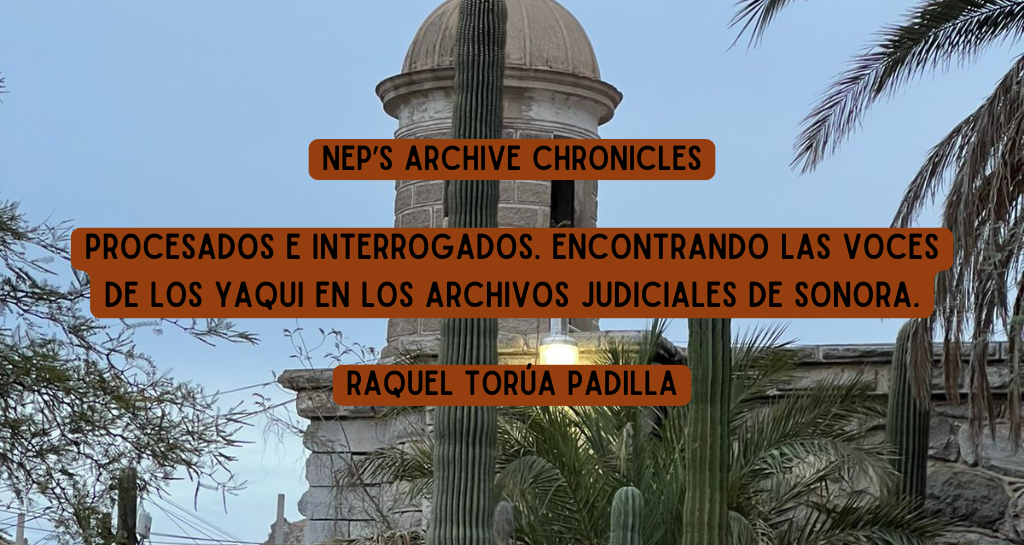
Camila Ordorica: Mexico’s General National Archive
In this piece, Camila Ordorica reflects on Mexico’s National General Archive and her method and experience in researching its history. This piece is available in English and Spanish.
“The AGN is currently housed in the Palace of Lecumberri. Originally inaugurated in 1900 by President Porfirio Díaz, the building was designed as a modern panoptical penitentiary. It served this purpose until 1972 when it was shut down due to a series of irregularities, corruption, and lack of space to sustain the growing inmate intake. After it shut down, a debate erupted in the Mexican press about its fate. Demolishing it would deprive both former inmates and the victims’ families of a significant place of memory. Additionally, opponents of its demolition emphasized the importance of preserving the building as a crucial site for studying and understanding the history of disciplinary architecture during the 20th century. But what to do with it?”
“Me senté frente a una computadora y escribí lo primero que se me ocurrió: «archivo». Pero al teclear una palabra que forma parte del nombre de toda la institución, el sistema transcribió toda la base de datos en la sección de resultados del programa, y lo colapsó. Pasé las siguientes semanas en Centro de Referencias analizando ArchiDoc, el gigantesco sistema de búsqueda del AGN, intentando averiguar cómo encontrar esta colección de la que nadie en el había oído hablar. Hasta que un día, a primera hora de la mañana, se acercó M. para decirme que había visto una colección en el perfil de administrador de ArchiDoc. Se llamaba Archivo Histórico Institucional (AHI) y figuraba en la sección del siglo XIX.”
